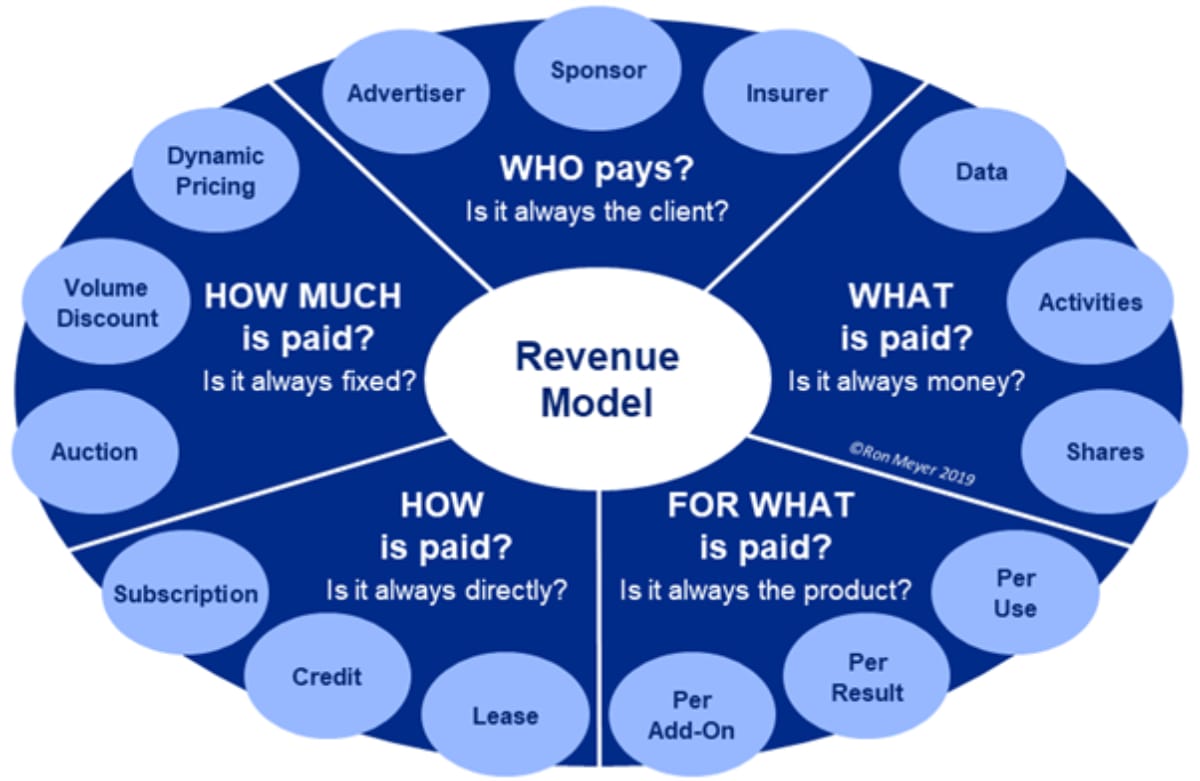Revenue Streams: How to Pick the Right One?

Choosing the right revenue stream is crucial for any business, as it defines how a company generates income and impacts its growth. With options ranging from direct product sales to licensing technology, the decision is complex but vital for long-term success.
A well-chosen revenue stream ensures steady cash flow, enhances customer value, and provides a competitive edge, while a poor choice can lead to instability. Businesses must consider profitability, market trends, customer preferences, and adaptability when selecting a revenue model. Understanding different revenue streams and aligning them with business goals is key to achieving financial stability and growth.
Understanding Different Types of Revenue Streams

To build a financially stable and growing business, understanding the various types of revenue streams is a critical first step. Each revenue stream has its unique characteristics, advantages, and challenges. Here are the six common types, providing a foundation for business owners to evaluate which streams might align best with their business model and goals.
1) Transaction-based Revenue
Transaction-based revenue is one of the most straightforward and commonly pursued streams. It involves earning income from individual sales of goods or services. Each transaction is a separate event, often with one-time customers or repeat purchases that occur irregularly. Retail stores, e-commerce platforms, and restaurants typically rely on this model. The key advantage is the potential for high volume and immediate revenue generation. However, it requires constant market demand and effective sales strategies to maintain a steady income flow.
2) Recurring Revenue
Recurring revenue is the holy grail for many businesses, offering a more predictable and stable cash flow compared to transaction-based models. This type involves regular payments from customers over a period, such as subscriptions or memberships. Companies like software providers, streaming services, and subscription box services thrive on this model. It creates customer loyalty and simplifies revenue forecasting, but demands continuous value delivery to prevent churn.
3) Project-based Revenue
Project-based revenue is common in industries such as construction, consulting, and creative services. It comes from contracts or projects completed over a specified period. This model allows businesses to work on multiple projects simultaneously, optimizing resource utilization and scaling income based on project size and complexity. The challenge lies in managing project timelines, costs, and client expectations to ensure profitability.
4) Service Fees
Service fees are charges for the provision of services, often seen in banking, brokerage, and professional services like legal and accounting firms. This stream can be transactional or recurring, depending on the service agreement. The advantage is the ability to charge premium prices based on expertise and service quality. However, it requires maintaining high service standards and client satisfaction to sustain revenue.
5) Licensing Revenue
Licensing allows businesses to earn money by permitting others to use their intellectual property (IP), such as patents, trademarks, or copyrights. This model is prevalent in technology, entertainment, and brand franchising. It provides a passive income stream with high profit margins, as the licensor incurs minimal additional costs. The main challenge is protecting IP rights and negotiating fair licensing agreements.
6) Advertising Revenue
Advertising revenue is generated by offering advertising space on platforms owned by the business. This can include online websites, mobile apps, or physical spaces. Media outlets, social networks, and content creators often leverage this stream. It requires attracting a significant audience to be attractive to advertisers but can be highly lucrative with high traffic volumes and engagement rates.

Aligning Revenue Streams with Business Goals
Selecting the right revenue stream involves more than understanding its mechanics; it requires aligning it with your business goals, market position, and customer base. For instance, if building long-term customer relationships is a priority, recurring revenue models like subscriptions might be ideal. Conversely, if you're operating in a highly innovative sector where IP is a core asset, licensing could unlock significant value.
Moreover, the choice isn't mutually exclusive. Many businesses adopt hybrid models, combining different revenue streams to diversify income sources and mitigate risks. For example, a software company might combine subscription services with project-based consulting and licensing of its technology.
In summary, the decision on which revenue stream to pursue is multifaceted, impacting every aspect of your business strategy. By understanding the different types of revenue streams and their implications, business owners can make informed decisions that pave the way for sustainable growth and profitability.
Factors to Consider When Choosing a Revenue Stream

Deciding on the right revenue stream is a strategic choice that influences not just the financial health of a business but its operational model, customer interactions, and market positioning. Several critical factors must be considered to ensure the chosen revenue stream aligns with the business's overall goals and market dynamics. Here, we explore key considerations that can guide this decision-making process.
Target Audience and Customer Demand
Understanding your target audience and their preferences is paramount. This involves analyzing customer behavior, needs, and willingness to pay for your product or service. For example, if your target market values flexibility and dislikes commitment, a subscription model may face resistance, whereas a transaction-based model could thrive. Aligning your revenue stream with customer demand ensures market relevance and creates customer satisfaction.
Business Model and Product/Service Type
The nature of your product or service plays a significant role in determining the most suitable revenue stream. Physical goods might lend themselves well to transaction-based models, while digital products or services could be more suited to subscriptions or licensing. Additionally, consider the cost of goods sold (COGS) and how different revenue models impact profitability and scalability.
Market Trends and Competition
Staying abreast of market trends and understanding the competitive landscape is crucial. Analyzing how competitors structure their revenue can provide insights into what works well in your industry. Furthermore, emerging trends might indicate shifts in consumer preferences, prompting a reevaluation of your revenue strategy to stay competitive and innovative.
Scalability and Sustainability
Some revenue streams offer greater scalability than others. For instance, digital products with low marginal costs can scale quickly through a subscription model. Evaluate how easily the revenue stream can grow with your business without proportionally increasing costs. Sustainability also factors in, considering the long-term viability of the revenue stream in changing market conditions.
Legal and Regulatory Considerations
Certain revenue streams may be subject to legal and regulatory restrictions that could impact your choice. For example, licensing intellectual property across different jurisdictions involves navigating copyright laws. Similarly, subscription models in some sectors might face regulatory scrutiny. Ensuring compliance while choosing a revenue stream is critical to avoid potential legal challenges.

Integrating Multiple Considerations
Choosing the right revenue stream often requires balancing these factors, considering both the internal capabilities of your business and external market conditions. It’s about finding a fit that not only maximizes revenue potential but also aligns with your business values, operational strengths, and long-term vision.
Flexibility and Adaptation
The ability to adapt your revenue model in response to feedback, market shifts, or internal changes is a valuable asset. Flexibility in your revenue strategy allows for pivoting when necessary, ensuring the business remains relevant and competitive.
The decision on which revenue stream to adopt is multi-faceted, requiring a deep understanding of your business, market, and customers. By carefully considering these factors, businesses can choose a revenue model that supports their growth, enhances customer value, and withstands the test of market dynamics and competition.
Strategies for Picking the Right Revenue Stream

Selecting the most suitable revenue stream for your business involves more than just analyzing your current position; it requires strategic planning and foresight. The right approach can help you capitalize on market opportunities, meet customer needs effectively, and set a solid foundation for sustainable growth. Here are key strategies to aid in making this crucial decision.
Conduct Market Research and Gather Customer Feedback
Understanding market needs and customer preferences is the core of choosing an effective revenue model. Conduct thorough market research to identify trends, demands, and gaps in the market. Use surveys, focus groups, and customer interviews to gather direct feedback on what your target audience values and is willing to pay for. This insight can guide you towards a revenue stream that aligns with customer expectations and market demand.
Perform Competitive Analysis
Look closely at your competitors’ revenue models to understand what works and why. Analyzing your competition can reveal strengths and weaknesses in their approaches, offering lessons on what to emulate or avoid. Additionally, identifying areas where your competitors are not fully serving the market can uncover opportunities for differentiation through your choice of revenue stream.
Develop and Test Pricing Strategies
Pricing significantly impacts customer decision-making and, consequently, your revenue stream's effectiveness. Develop a pricing strategy that reflects the value you provide, the market rate for similar offerings, and your cost structure. Consider testing different pricing levels and structures (e.g., tiered pricing, freemium models) to gauge customer response and adjust accordingly. This iterative process can help pinpoint the most profitable approach.
Embrace Diversification and Risk Management
Relying on a single revenue stream can be risky, especially in volatile markets. Diversification—incorporating multiple revenue streams—can spread risk and increase resilience. For example, a software company might combine subscription fees with pay-per-use licenses and consultancy services. Assess the feasibility of diversifying your revenue streams to stabilize income and leverage different market segments.
Utilize Testing and Adaptation
The business environment is dynamic, and customer preferences can shift. Launch pilot programs or beta versions of your product or service to test how different revenue models perform in real-world conditions. Monitor performance closely, using metrics such as customer acquisition cost, lifetime value, churn rate, and profitability. Be prepared to adapt your revenue model based on these insights and evolving market conditions.
Implementing the Strategy
Implementing your chosen strategy requires careful planning and execution. Start small with a focused target market or product offering to minimize risk. Use the feedback and data gathered to refine your approach before a full-scale rollout. Ensure that your business operations, including sales, marketing, and customer support, are aligned with the chosen revenue model to maximize its effectiveness.
Monitoring and Continuous Improvement
Choosing a revenue stream is not a one-time decision. Continuous monitoring of its performance, market trends, and customer feedback is essential. Be open to revisiting and revising your revenue model as your business grows and as external conditions change. This flexibility can be a critical factor in your long-term success and sustainability.
Selecting the right revenue stream is a strategic decision that requires careful consideration, research, and testing. By understanding your market, customers, and competition, and by being willing to adapt, you can identify a revenue model that supports your business goals and drives growth. Remember, the best choice is one that not only generates revenue but also aligns with your business values, enhances customer relationships, and positions you favorably in the competitive landscape.
Case Studies: Successful Revenue Stream Selection

Understanding the practical application and impact of selecting the right revenue streams can be best illustrated through real-world case studies. These examples showcase businesses that have adeptly navigated the complexities of revenue model selection, offering valuable lessons on adaptability, market understanding, and strategic planning.
Case Study 1: A Tech Startup's Shift to Subscription Model
Background: A tech startup initially launched with a single-purchase software product, aiming to capitalize on high initial sales. However, as market saturation approached and sales plateaued, the need for a more sustainable revenue model became apparent.
Strategy: After conducting market research and gathering customer feedback, the startup recognized a growing preference for SaaS (Software as a Service) models among their target audience. This insight led them to transition to a subscription-based model, offering monthly and annual payment options.
Outcome: The shift to a subscription model transformed the startup's revenue stream, providing a more predictable, recurring income that enhanced financial stability. Customer retention rates improved due to the continuous updates and support provided, creating a stronger customer relationship. This model also enabled the startup to scale more effectively, expanding their market reach and product offerings based on ongoing customer feedback.
Lesson: Flexibility and a deep understanding of customer preferences are crucial in choosing a revenue stream that supports long-term growth.
Case Study 2: A Traditional Retailer's Adoption of E-commerce
Background: A traditional brick-and-mortar retailer faced challenges with fluctuating foot traffic and sales. With the rise of online shopping, they sought to expand their market presence and reach more customers.
Strategy: The retailer decided to adopt an e-commerce model in addition to their physical stores. They invested in developing an online platform that mirrored the in-store experience, offering online-exclusive products and promotions to attract customers.
Outcome: The introduction of an e-commerce channel significantly broadened the retailer's revenue stream, allowing them to tap into a wider audience. Online sales complemented their physical store sales, particularly during off-peak seasons, stabilizing their overall revenue. Furthermore, the retailer utilized customer data from online sales to better understand consumer behavior, informing both online and in-store strategies.
Lesson: Diversifying revenue streams by embracing digital transformation can open new markets and stabilize income.
Case Study 3: A Service Provider's Leverage of Licensing
Background: A service provider in the technology sector developed a proprietary software tool that improved operational efficiency. Recognizing the tool's value beyond their internal use, they explored additional revenue opportunities.
Strategy: The company decided to license the software tool to other businesses, creating a new revenue stream without diverting from their core service offerings. They established flexible licensing options, catering to different business sizes and needs.
Outcome: Licensing the software tool not only generated a new source of income but also positioned the company as an innovator in their industry. The additional revenue supported further research and development, enhancing their service offerings and the licensed product. This strategy also created partnerships and collaborations, expanding their business network.
Lesson: Leveraging intellectual property through licensing can provide a lucrative revenue stream while reinforcing industry leadership and innovation.
These case studies illustrate the importance of strategic revenue stream selection and the potential for innovation and growth that comes with it. By understanding their market, listening to their customers, and being willing to adapt, these businesses were able to identify and implement revenue models that drove their success. The key takeaway is the significance of aligning revenue streams with business goals, market needs, and customer preferences, ensuring sustainability and competitive advantage.
Final Thoughts
Selecting the right revenue stream is critical for any business, shaping its ability to generate income, grow, and adapt to changes. This article has explored various revenue stream types, key factors to consider, and real-world examples of successful strategies. Aligning your revenue model with business goals, market dynamics, and customer needs is essential for success.
Finding the most suitable revenue stream requires ongoing research, flexibility, and adaptation to market shifts. Successful businesses continuously refine their revenue models to stay competitive and meet financial objectives. With the insights shared, entrepreneurs can make informed decisions to drive long-term growth and sustainability.
Key Takeaways
| Section | Key Takeaways |
|---|---|
| Introduction | The choice of revenue stream significantly impacts a business's sustainability and growth trajectory. |
| Understanding Different Types of Revenue Streams | Various revenue streams include transaction-based, recurring, project-based, service fees, licensing, and advertising revenues, each with unique benefits and challenges. |
| Factors to Consider When Choosing a Revenue Stream | Key considerations include target audience and customer demand, business model and product/service type, market trends and competition, scalability and sustainability, and legal and regulatory considerations. |
| Strategies for Picking the Right Revenue Stream | Effective strategies involve conducting market research, performing competitive analysis, developing and testing pricing strategies, embracing diversification, and utilizing testing and adaptation. |
| Case Studies: Successful Revenue Stream Selection | Real-world examples highlight the importance of flexibility, market understanding, and strategic planning in successfully selecting and implementing revenue models. |
| Conclusion | The strategic selection of revenue streams is crucial for business success, requiring ongoing analysis, experimentation, and refinement to stay aligned with market dynamics and customer needs. |





